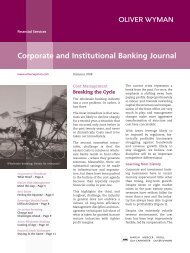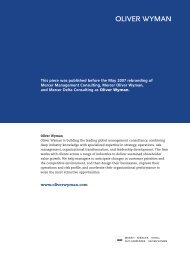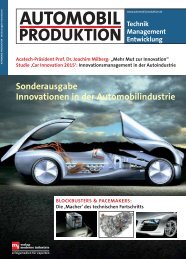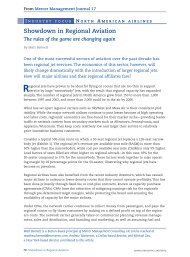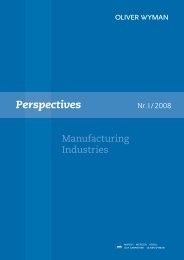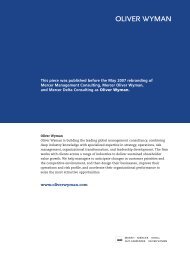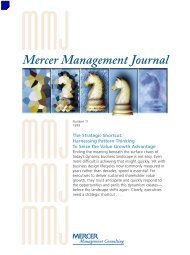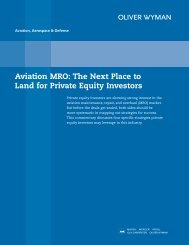Corporate Portfolio Management - Oliver Wyman
Corporate Portfolio Management - Oliver Wyman
Corporate Portfolio Management - Oliver Wyman
Create successful ePaper yourself
Turn your PDF publications into a flip-book with our unique Google optimized e-Paper software.
<strong>Corporate</strong> Risk<br />
<strong>Corporate</strong> <strong>Portfolio</strong> <strong>Management</strong><br />
Capital allocation from a risk-return perspective
Premise<br />
Aligning the right information with the right people to make effective<br />
corporate decisions is one of the most common challenges facing<br />
senior management today. When addressing capital allocation and<br />
investment decisions, this challenge becomes even more formidable.<br />
The most critical determinant of an organization’s long-term value is<br />
its ability to optimally allocate limited capital among large projects,<br />
new markets and merger and acquisition (M&A) decisions. Successful<br />
organizations make large investment and capital allocation decisions<br />
using a robust approach that analyzes each option’s ‘risk-return<br />
trade-off’ and reflects each option’s overall impact on the existing<br />
portfolio. Poor investments, on the other hand, can result in share<br />
price depression, lost market share, departure of key leadership and<br />
negative media attention.<br />
By incorporating a risk-return perspective into <strong>Corporate</strong> <strong>Portfolio</strong><br />
<strong>Management</strong>, organizations will be better equipped to answer the<br />
following questions:<br />
.<br />
.<br />
.<br />
.<br />
How can risk <br />
be incorporated into the decision making process so<br />
that multiple investment options are consistently evaluated?<br />
Will the expected return in any single investment justify the level<br />
of risk required to pursue this option?<br />
What is the optimal combination of investment options to achieve<br />
our mid- and long-term strategic objectives?<br />
Where should I spend my next investment dollar?<br />
Risk refers to the volatility of performance (e.g. cash flow, earnings)<br />
<br />
Copyright 2007 © <strong>Oliver</strong> <strong>Wyman</strong>
Utilizing a risk-return perspective to support these decisions will<br />
allow a firm to sustain growth and create long-term value. It can be<br />
applied to a wide variety of industry examples:<br />
• Media and technology companies determining an appropriate<br />
business portfolio amid technological uncertainty<br />
• Energy companies selecting an exploration portfolio amid political<br />
and price uncertainty<br />
• Aerospace and automotive manufacturers choosing between<br />
business segments amid demand and project execution uncertainty<br />
• Pharmaceutical companies allocating R&D dollars based on a<br />
portfolio view of their pipeline<br />
• Companies considering a make vs. buy outsourcing decision within<br />
their supply chain<br />
• Real estate companies determining the right mix of geographic vs.<br />
use combinations<br />
Copyright 2007 © <strong>Oliver</strong> <strong>Wyman</strong>
Risk-based decision-making<br />
Investment decision making has traditionally incorporated risk<br />
through the application of the Weighted Average Cost of Capital<br />
(WACC) to Discounted Cash Flow and Net Present Value calculations.<br />
However, the primary risk elements within WACC (risk premium and<br />
debt/equity mix) do not address all of the risks of the investment,<br />
especially those that are smaller and not easily quantifiable. For<br />
example, a WACC approach does not explicitly consider risks such<br />
as competitive response or technological shifts; these are reflected<br />
only in an intuitive manner. We have found that organizations often<br />
adjust the WACC ‘up or down, depending on how risky the investment<br />
intuitively feels.’ One Fortune 500 CFO candidly summed up this<br />
approach by stating, “If I like the investment, the WACC is 11%. If not,<br />
it’s 14%.”<br />
This approach, however, relies far too heavily on judgment and intuition,<br />
and should be combined with a more robust analysis that considers<br />
factors beyond the current and expected states of the business. Such<br />
an analysis should incorporate all internal (strategic, operational and<br />
organizational) and external (macroeconomic, competitive, political and<br />
counterparty) risks that are introduced, as well.<br />
By blending analytic risk assessment techniques into financial asset<br />
portfolio theory, senior management can utilize more robust decision<br />
making tools to answer the key questions surrounding optimal<br />
investment allocation outlined above. Additionally, senior management<br />
will be able to systematically include risk in investment evaluation,<br />
resulting in better management of corporate assets from a risk-return<br />
perspective, as illustrated by the case study presented in Figure 1.<br />
<br />
Copyright 2007 © <strong>Oliver</strong> <strong>Wyman</strong>
Figure 1: Case Study<br />
How a large manufacturing firm created an internal<br />
competitive capital marketplace?<br />
Situation:<br />
• The organisation had transformed itself from a state-owned conglomerate<br />
focusing mainly on domestic activities to a global player with multiple<br />
global assets<br />
• With a high level of ongoing M&A activity, continual evaluation of highly<br />
capital-intensive investments and increasing exposure to international<br />
markets, the CFO wanted to improve the organisation’s ability to compare<br />
multiple options from a true risk-return perspective in order to maximize<br />
value creation<br />
Solution:<br />
A three-pronged framework to support capital decision making: risk-return<br />
assessment, risk-adjusted WACC, and risk-return portfolio modelling<br />
• Risk assessments: in each business unit are conducted using a Mercer <strong>Oliver</strong><br />
<strong>Wyman</strong> methodology that supports consistent and systematic identification<br />
and quantification of all key risks within the business unit using common<br />
risk metrics<br />
• Risk-adjusted WACC: Enables the organisation to incorporate the outputs<br />
from the risk assessment into the WACC for each BU and investment decision<br />
by defining the ‘risk-adjusted capital structure’ required (See Figure 2)<br />
• The risk-return portfolio model: Defines the risk-return position of each<br />
of the company’s assets, taking into consideration return on capital, risk,<br />
growth and correlations. The model allows the user to calculate the current<br />
position in the risk-return space (as a group) and evaluate how the group<br />
risk-return position would change as a consequence of new investments<br />
and/or acquisitions (See Figure 4)<br />
Results:<br />
• The organisation now accounts for the risk exposure within each business<br />
unit, investment opportunity or acquisition target using enhanced,<br />
quantitative risk assessment techniques.<br />
• Decisions are based on strategic objective alignment as well as the<br />
prospective risk-adjusted return impact.<br />
• Information is updated on an ongoing basis as relevant, new options<br />
emerge<br />
Copyright 2007 © <strong>Oliver</strong> <strong>Wyman</strong>
Application<br />
In our experience, we have found that the best approach utilizes three<br />
elements to develop a competitive internal capital marketplace for<br />
the organization: risk assessment, risk-adjusted WACC and risk-return<br />
portfolio optimization.<br />
1. Risk assessment<br />
<strong>Management</strong> should first undertake a detailed risk assessment that<br />
includes identification and quantification of all material risks in order<br />
to provide a clear understanding of current volatility in each portfolio<br />
entity (e.g. business unit, region, facility, program).<br />
In this assessment process, management must first focus on<br />
developing a comprehensive understanding of risks from all risk<br />
categories (financial, strategic, operational, and hazard). The goal<br />
of the risk identification exercise is to highlight the risks that can<br />
have a material impact on the value of the company. The second<br />
step requires that a risk profile be developed through a quantitative<br />
analysis (either top-down or bottom-up) of volatility in the projected<br />
financial performance (Figure 2).<br />
This type of assessment goes beyond the relative prioritization of key<br />
risks typically found on ‘heat or risk maps’ and offers quantitative<br />
risk metrics for use in decision making. In addition, this risk<br />
assessment highlights the cross-correlations between business units<br />
as well as new investment options, providing senior management<br />
with a more robust view of overall volatility and portfolio<br />
diversification effects.<br />
<br />
Copyright 2007 © <strong>Oliver</strong> <strong>Wyman</strong>
Figure 2: Risk assessment<br />
1<br />
2<br />
Risk identification<br />
Risk quantification<br />
Financial<br />
risks<br />
Operational<br />
risks<br />
Impact on<br />
value<br />
Strategic<br />
risks<br />
Hazard<br />
risks<br />
Risk profile<br />
5%<br />
Planned<br />
4%<br />
3%<br />
2%<br />
1%<br />
0%<br />
(144) (80) (16) 48 112 175 239 303<br />
Cash flow at risk<br />
Option 1: Top-down ‘benchmark’ approach<br />
Option 2: Bottom-up ‘risk driver’ approach<br />
Risk assessment process generates a risk profile for each portfolio entity<br />
and any new portfolio investment options under consideration<br />
Once the risk assessment process has been completed, it provides<br />
the risk profile for each business unit detailed according to the<br />
methodology used. The bottom-up approach tends to be more fulsome,<br />
including specific information regarding each of the risks and risk<br />
drivers identified in the risk identification exercise. The top-down<br />
approach incorporates benchmarking information from across all<br />
relevant peer companies and sectors and focuses on using empirical<br />
data and scenario analysis in the development of the risk profiles.<br />
On its own, the traditional risk assessment does not solve the<br />
fundamental problem of integrating risk with decision making. In<br />
fact, most companies have conducted some form of risk assessment<br />
without forging this link. Our methodology ensures a more<br />
quantitative form of risk assessment that serves as the foundation for<br />
the two steps that follow.<br />
2. Risk-adjusted WACC<br />
Risk can be further integrated into investment decisions by adjusting<br />
the organization’s existing WACC or investment hurdle rates<br />
according to the risk assessment outputs. This risk-adjusted WACC,<br />
which can be applied to business units or investment options,<br />
incorporates more than the typical cost of debt, cost of equity and<br />
debt/equity split components. The risk-adjusted WACC also reflects all<br />
risks and risk drivers for each current business and new investment<br />
option under consideration.<br />
Copyright 2007 © <strong>Oliver</strong> <strong>Wyman</strong>
Operating under the theory of economic capital , our methodology<br />
adjusts the current hurdle rate according to the financial volatility of<br />
each portfolio entity and/or investment option under consideration.<br />
The volatility changes the equity capital requirement of each<br />
portfolio entity to create a ‘risk-adjusted debt/equity split,’ which<br />
is then used to determine the risk-adjusted WACC (Figure 3). This<br />
process also properly integrates diversification value into the<br />
analysis by considering the correlations between each of the portfolio<br />
components.<br />
Figure 3: Risk-adjusted WACC<br />
Investment option 1<br />
Business unit 2<br />
Business unit 1<br />
Your hurdle<br />
rate today<br />
Revised<br />
+ Earnings<br />
debt/equity =<br />
split<br />
Risk-adjusted<br />
hurdle rate<br />
Cost of debt<br />
Cost of equity<br />
Debt/equity split<br />
Correlations<br />
with group<br />
3. Risk-return portfolio modeling<br />
In addition to the risk-adjusted WACC approach described above,<br />
<strong>Oliver</strong> <strong>Wyman</strong> has developed a risk-return modeling exercise that<br />
provides management with:<br />
• A before and after view of the business portfolio, pre and post new<br />
investments, from a ‘risk-return perspective’<br />
• A ‘risk-return efficient frontier’ that presents a series of potential<br />
options that boundary the optimal risk-return positions (knowing<br />
the efficient frontier can be especially effective in helping an<br />
organization define its risk appetite)<br />
• A view of the direction of the company’s portfolio and how it<br />
should migrate over time through a strategic plan<br />
• The ability to plot new investment targets on the risk-return matrix<br />
and assess how well the organization is moving toward its optimal<br />
desired risk-return position<br />
The equity capital an organization should hold given the risk of its business activities,<br />
taking into account its own risk appetite<br />
<br />
Copyright 2007 © <strong>Oliver</strong> <strong>Wyman</strong>
The portfolio modeling tool factors in a number of key inputs such<br />
as current returns, growth expectations and cross-correlations<br />
among existing business units, acquisition targets and investment<br />
opportunities. The quantitative risk metrics developed during the risk<br />
assessment are the most important of these inputs, as they provide<br />
the basis for including risk into capital allocation decisions (Figure 4).<br />
Figure 4: Risk-return portfolio optimization<br />
Key aspects of investment<br />
decision-making<br />
Return<br />
Identify potential<br />
portfolio solutions<br />
Return<br />
– Earnings performance<br />
– Growth<br />
– Capital requirements<br />
Risk<br />
– Volatility of returns<br />
– Downside exposure<br />
– Correlations<br />
Strategic importance<br />
– New markets/technology<br />
– Consolidation/scale<br />
BU 3<br />
BU 1<br />
Option 1<br />
Option 2<br />
Risk-return<br />
efficient frontier<br />
Group today<br />
BU 4<br />
BU 2<br />
Risk<br />
Business units (BU)<br />
Investment options<br />
Group today<br />
Strategic alternatives can then be viewed through a risk-return prism<br />
that defines new investments by analyzing the risk-return positions,<br />
the investment’s impact on the group positioning and its relationship<br />
to the organization’s overall risk appetite and direction.<br />
Copyright 2007 © <strong>Oliver</strong> <strong>Wyman</strong>
Conclusion<br />
While investment decisions should include the strategic concerns<br />
and management perspectives that pushed the company to initially<br />
investigate a given investment option, a risk-return quantitative<br />
analysis ensures that management will neither overpay for the<br />
potential strategic gain nor underestimate the potential risks of any<br />
new investment.<br />
In comparison to current risk-based decision making practices, the<br />
<strong>Corporate</strong> <strong>Portfolio</strong> <strong>Management</strong> approach provides the following<br />
benefits:<br />
• Increased decision making transparency through a more consistent<br />
evaluation of all business units and options<br />
• A consistent approach to risk measurement<br />
• A systematic way of including different views of risk in decisionmaking<br />
process<br />
• A clear enhancement to the due diligence process<br />
• Better understanding of value creation among new investment<br />
opportunities<br />
• Consideration of the correlation and diversification effects of the<br />
organization’s different businesses and investment options<br />
• Guidance for strategic planning (e.g. identification of where the<br />
company needs to move to improve its risk-return position)<br />
• Consideration of qualitative and non-financial implications<br />
These benefits can easily be recognized across most organizations,<br />
regardless of size or industry. Our experience has shown us that a<br />
great deal of the information and expertise required by the <strong>Corporate</strong><br />
<strong>Portfolio</strong> <strong>Management</strong> approach is already available within an<br />
organization. The key is to ensure that management understands<br />
and continually evaluates the risk-return position of both their<br />
organization’s assets and new investment opportunities to create the<br />
most value in the long-term.<br />
10 Copyright 2007 © <strong>Oliver</strong> <strong>Wyman</strong>
<strong>Oliver</strong> <strong>Wyman</strong> is building the leading global management consultancy, combining deep industry knowledge<br />
with specialized expertise in strategy, operations, risk management, organizational transformation, and<br />
leadership development.<br />
For more information please contact:<br />
North America<br />
marketingna@oliverwyman.com<br />
+1 212 541 8100<br />
EMEA<br />
marketingeu@oliverwyman.com<br />
+44 20 7333 8333<br />
Asia Pacific<br />
marketingasia@oliverwyman.com<br />
+65 6510 9700<br />
Copyright © 2006-2007 <strong>Oliver</strong> <strong>Wyman</strong> Limited. All rights reserved. This report may not be reproduced or redistributed, in whole or in part, without the<br />
written permission of <strong>Oliver</strong> <strong>Wyman</strong> and <strong>Oliver</strong> <strong>Wyman</strong> accepts no liability whatsoever for the actions of third parties in this respect.<br />
The information and opinions in this report were prepared by <strong>Oliver</strong> <strong>Wyman</strong>.<br />
This report is not a substitute for tailored professional advice on how a specific financial institution should execute its strategy. This report is not<br />
investment advice and should not be relied on for such advice or as a substitute for consultation with professional accountants, tax, legal or financial<br />
advisers. <strong>Oliver</strong> <strong>Wyman</strong> has made every effort to use reliable, up-to-date and comprehensive information and analysis, but all information is provided<br />
without warranty of any kind, express or implied. <strong>Oliver</strong> <strong>Wyman</strong> disclaims any responsibility to update the information or conclusions in this report. <strong>Oliver</strong><br />
<strong>Wyman</strong> accepts no liability for any loss arising from any action taken or refrained from as a result of information contained in this report or any reports or<br />
sources of information referred to herein, or for any consequential, special or similar damages even if advised of the possibility of such damages.<br />
This report may not be sold without the written consent of <strong>Oliver</strong> <strong>Wyman</strong>.



